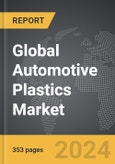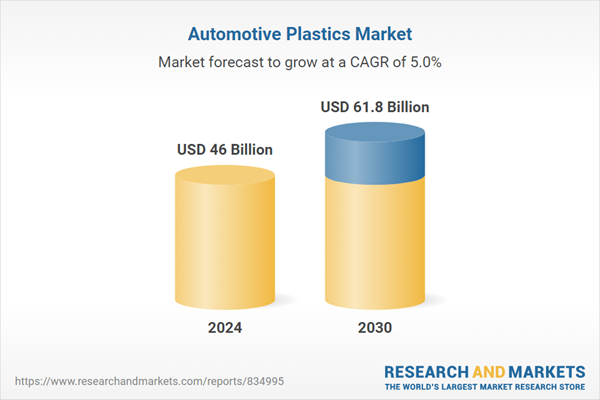The global market for Automotive Plastics was valued at US$46.0 Billion in 2024 and is projected to reach US$61.8 Billion by 2030, growing at a CAGR of 5.0% from 2024 to 2030. This comprehensive report provides an in-depth analysis of market trends, drivers, and forecasts, helping you make informed business decisions. The report includes the most recent global tariff developments and how they impact the Automotive Plastics market.
Segments: Product Type (Polypropylene (PP), Polyurethane (PU), Acrylonitrile Butadiene Styrene (ABS), Polyamide (PA), Polyvinylchloride (PVC), Polycarbonate (PC), Other Products); Application (Interior, Exterior, Under Bonnet, Other Applications).
Geographic Regions/Countries: World; United States; Canada; Japan; China; Europe (France; Germany; Italy; United Kingdom; Spain; Russia; and Rest of Europe); Asia-Pacific (Australia; India; South Korea; and Rest of Asia-Pacific); Latin America (Argentina; Brazil; Mexico; and Rest of Latin America); Middle East (Iran; Israel; Saudi Arabia; United Arab Emirates; and Rest of Middle East); and Africa.
The analysts continuously track trade developments worldwide, drawing insights from leading global economists and over 200 industry and policy institutions, including think tanks, trade organizations, and national economic advisory bodies. This intelligence is integrated into forecasting models to provide timely, data-driven analysis of emerging risks and opportunities.
Global Automotive Plastics Market - Key Trends and Drivers Summarized
How Are Automotive Plastics Revolutionizing Vehicle Design?
Automotive plastics are playing a pivotal role in revolutionizing vehicle design and manufacturing. These materials, including polypropylene, polyurethane, polyvinyl chloride (PVC), and acrylonitrile butadiene styrene (ABS), offer a unique combination of strength, flexibility, and lightweight properties. Their versatility allows for intricate and innovative designs that were previously unattainable with traditional materials like metal and glass. Automotive plastics are used extensively in both interior and exterior components, such as dashboards, door panels, bumpers, and fuel systems. Their ability to be molded into complex shapes enhances the aesthetic appeal of vehicles while also contributing to improved aerodynamics and fuel efficiency. The use of plastics in vehicle construction also facilitates the integration of advanced features like infotainment systems and enhanced safety components, further pushing the boundaries of modern automotive design.What Role Do Automotive Plastics Play in Sustainability?
The shift towards sustainability in the automotive industry is significantly driven by the use of plastics. The lightweight nature of automotive plastics contributes to substantial weight reduction in vehicles, which directly impacts fuel consumption and greenhouse gas emissions. Lighter vehicles require less energy to operate, leading to improved fuel efficiency and reduced environmental footprint. Additionally, automotive plastics are increasingly being sourced from recycled and bio-based materials, further enhancing their environmental benefits. This shift aligns with the industry's goals of reducing reliance on non-renewable resources and minimizing waste. Innovations in recycling technologies are also enabling the efficient recovery and reuse of plastic components, promoting a circular economy within the automotive sector. As regulatory pressures for greener vehicles intensify, the role of sustainable plastics in meeting these demands becomes even more critical.What Innovations Are Shaping the Future of Automotive Plastics?
The future of automotive plastics is being shaped by several key innovations. One significant trend is the development of high-performance composites that combine plastics with materials like carbon fiber and glass fiber. These composites offer superior strength-to-weight ratios, making them ideal for critical structural components while maintaining lightweight characteristics. Advances in additive manufacturing, or 3D printing, are also revolutionizing the production of automotive plastic parts, allowing for rapid prototyping and customization at reduced costs. Furthermore, smart plastics equipped with sensors and electronic functionalities are emerging, enabling advanced driver assistance systems (ADAS) and enhanced vehicle connectivity. These smart materials can monitor and respond to environmental conditions, contributing to the safety and performance of modern vehicles. Another innovation is the introduction of self-healing plastics, which can repair minor damages autonomously, extending the lifespan of automotive components and reducing maintenance costs.What Factors Are Driving the Growth in the Automotive Plastics Market?
The growth in the automotive plastics market is driven by several factors. The increasing demand for lightweight and fuel-efficient vehicles is a primary driver, as manufacturers strive to meet stringent emission regulations and consumer expectations for greener transportation options. Technological advancements in material science and manufacturing processes are enabling the production of more robust and versatile plastic components, expanding their applications within the automotive industry. The rising trend of electric vehicles (EVs) is also contributing to market growth, as plastics play a crucial role in lightweighting and insulating battery systems. Additionally, the push for sustainability is propelling the adoption of recycled and bio-based plastics, aligning with global efforts to reduce environmental impact. The integration of smart technologies and the need for cost-effective manufacturing solutions are further accelerating the demand for automotive plastics. As the automotive industry continues to evolve, the role of plastics in driving innovation, efficiency, and sustainability is set to become even more significant.Report Scope
The report analyzes the Automotive Plastics market, presented in terms of units. The analysis covers the key segments and geographic regions outlined below.Segments: Product Type (Polypropylene (PP), Polyurethane (PU), Acrylonitrile Butadiene Styrene (ABS), Polyamide (PA), Polyvinylchloride (PVC), Polycarbonate (PC), Other Products); Application (Interior, Exterior, Under Bonnet, Other Applications).
Geographic Regions/Countries: World; United States; Canada; Japan; China; Europe (France; Germany; Italy; United Kingdom; Spain; Russia; and Rest of Europe); Asia-Pacific (Australia; India; South Korea; and Rest of Asia-Pacific); Latin America (Argentina; Brazil; Mexico; and Rest of Latin America); Middle East (Iran; Israel; Saudi Arabia; United Arab Emirates; and Rest of Middle East); and Africa.
Key Insights:
- Market Growth: Understand the significant growth trajectory of the Polypropylene (PP) segment, which is expected to reach US$23.4 Billion by 2030 with a CAGR of a 5.9%. The Polyurethane (PU) segment is also set to grow at 4.7% CAGR over the analysis period.
- Regional Analysis: Gain insights into the U.S. market, valued at $12.2 Billion in 2024, and China, forecasted to grow at an impressive 8.5% CAGR to reach $13.6 Billion by 2030. Discover growth trends in other key regions, including Japan, Canada, Germany, and the Asia-Pacific.
Why You Should Buy This Report:
- Detailed Market Analysis: Access a thorough analysis of the Global Automotive Plastics Market, covering all major geographic regions and market segments.
- Competitive Insights: Get an overview of the competitive landscape, including the market presence of major players across different geographies.
- Future Trends and Drivers: Understand the key trends and drivers shaping the future of the Global Automotive Plastics Market.
- Actionable Insights: Benefit from actionable insights that can help you identify new revenue opportunities and make strategic business decisions.
Key Questions Answered:
- How is the Global Automotive Plastics Market expected to evolve by 2030?
- What are the main drivers and restraints affecting the market?
- Which market segments will grow the most over the forecast period?
- How will market shares for different regions and segments change by 2030?
- Who are the leading players in the market, and what are their prospects?
Report Features:
- Comprehensive Market Data: Independent analysis of annual sales and market forecasts in US$ Million from 2024 to 2030.
- In-Depth Regional Analysis: Detailed insights into key markets, including the U.S., China, Japan, Canada, Europe, Asia-Pacific, Latin America, Middle East, and Africa.
- Company Profiles: Coverage of players such as Akzo Nobel NV, BASF SE, Borealis AG, Covestro AG, Dow Inc. and more.
- Complimentary Updates: Receive free report updates for one year to keep you informed of the latest market developments.
Some of the 181 companies featured in this Automotive Plastics market report include:
- Akzo Nobel NV
- BASF SE
- Borealis AG
- Covestro AG
- Dow Inc.
- Evonik Industries AG
- Grupo Antolin-Irausa SA
- Hanwha Azdel, Inc.
- Johnson Controls, Inc.
- Lear Corporation
- Magna International, Inc.
- Momentive Performance Materials, Inc.
- Owens Corning
- Royal DSM NV
- SABIC (Saudi Basic Industries Corporation)
- Teijin Ltd.
Tariff Impact Analysis: Key Insights for 2025
Global tariff negotiations across 180+ countries are reshaping supply chains, costs, and competitiveness. This report reflects the latest developments as of April 2025 and incorporates forward-looking insights into the market outlook.The analysts continuously track trade developments worldwide, drawing insights from leading global economists and over 200 industry and policy institutions, including think tanks, trade organizations, and national economic advisory bodies. This intelligence is integrated into forecasting models to provide timely, data-driven analysis of emerging risks and opportunities.
What’s Included in This Edition:
- Tariff-adjusted market forecasts by region and segment
- Analysis of cost and supply chain implications by sourcing and trade exposure
- Strategic insights into geographic shifts
Buyers receive a free July 2025 update with:
- Finalized tariff impacts and new trade agreement effects
- Updated projections reflecting global sourcing and cost shifts
- Expanded country-specific coverage across the industry
Table of Contents
I. METHODOLOGYII. EXECUTIVE SUMMARY2. FOCUS ON SELECT PLAYERSIII. MARKET ANALYSISCANADAITALYSPAINRUSSIAREST OF EUROPESOUTH KOREAREST OF ASIA-PACIFICARGENTINABRAZILMEXICOREST OF LATIN AMERICAIRANISRAELSAUDI ARABIAUNITED ARAB EMIRATESREST OF MIDDLE EASTIV. COMPETITION
1. MARKET OVERVIEW
3. MARKET TRENDS & DRIVERS
4. GLOBAL MARKET PERSPECTIVE
UNITED STATES
JAPAN
CHINA
EUROPE
FRANCE
GERMANY
UNITED KINGDOM
ASIA-PACIFIC
AUSTRALIA
INDIA
LATIN AMERICA
MIDDLE EAST
AFRICA
Companies Mentioned (Partial List)
A selection of companies mentioned in this report includes, but is not limited to:
- Akzo Nobel NV
- BASF SE
- Borealis AG
- Covestro AG
- Dow Inc.
- Evonik Industries AG
- Grupo Antolin-Irausa SA
- Hanwha Azdel, Inc.
- Johnson Controls, Inc.
- Lear Corporation
- Magna International, Inc.
- Momentive Performance Materials, Inc.
- Owens Corning
- Royal DSM NV
- SABIC (Saudi Basic Industries Corporation)
- Teijin Ltd.
Table Information
| Report Attribute | Details |
|---|---|
| No. of Pages | 353 |
| Published | April 2025 |
| Forecast Period | 2024 - 2030 |
| Estimated Market Value ( USD | $ 46 Billion |
| Forecasted Market Value ( USD | $ 61.8 Billion |
| Compound Annual Growth Rate | 5.0% |
| Regions Covered | Global |









